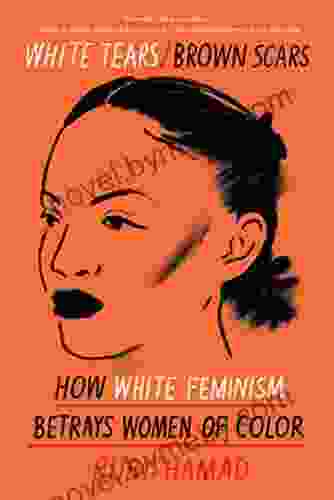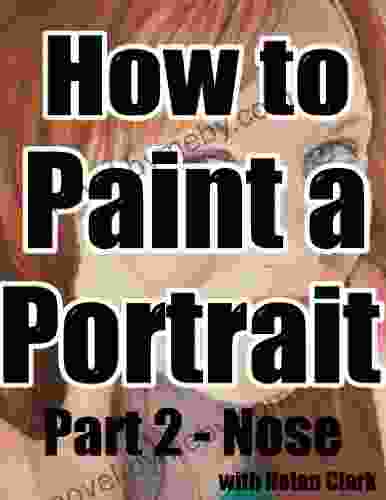Mastering Noses in Portraiture: A Comprehensive Guide for Artists

The nose, a prominent facial feature, plays a crucial role in defining the character and expression of a portrait. Capturing its complexities and nuances requires a keen understanding of anatomy, lighting, and color theory. In this comprehensive guide, we embark on a journey to explore the art of painting noses in portraiture, equipping you with the knowledge and techniques necessary to render this feature with precision and artistry. 4.8 out of 5 To paint a realistic nose, it's essential to grasp its underlying structure. The nose consists of bone and cartilage, with the nasal bones forming the bridge and upper portion. The cartilaginous lower part includes the septum, which divides the nasal cavity, and the alae nasi, or side walls, that flare when we breathe. Understanding the interplay of these elements and their contours is crucial for rendering the nose's shape and depth accurately.Language : English File size : 11426 KB Text-to-Speech : Enabled Screen Reader : Supported Enhanced typesetting : Enabled Print length : 75 pages Lending : Enabled Anatomical Overview

Lighting and Shadows
Lighting plays a vital role in shaping the appearance of the nose. Observe how light falls on the nose and creates highlights, midtones, and shadows. Pay attention to the subtle transitions between these areas, which define the form and volume.
The bridge of the nose is typically the lightest part, while the sides of the nose and the nostrils recede into shadow. The angle of the light source determines the direction and intensity of these shadows.

Color and Tone
The color of the nose varies depending on the individual's skin tone. Warm tones, such as pinks and reds, are often present in areas closest to the light source. As we move away from the light, cooler tones, such as blues and greens, appear in the shadows.
Observing the subtle variations in color and tone is essential for capturing the unique characteristics of each nose. Avoid using pure colors; instead, mix and blend complementary colors to create nuanced and realistic tones.

Techniques and Brushes
Various brush techniques and types can be employed to paint noses effectively. Start by blocking in the basic shape with a medium-sized brush. Use a round brush for precision when defining details and contours.
Experiment with dry brushing to create subtle textures on the skin surface. Stippling is another useful technique to build up color and create the illusion of depth. For blending, a soft brush with a large surface area works well.

Step-by-Step Tutorial
To illustrate the process, let's walk through a step-by-step tutorial on how to paint a nose:
- Sketch the outline: Begin by lightly sketching the outline of the nose, capturing its overall shape and proportions.
- Block in the basic colors: Using a medium-sized brush, block in the main color areas of the nose. Keep the colors simple at this stage.
- Define the structure: Use a round brush to define the contours and shadows of the nose. Pay attention to the transitions between light and dark areas.
- Add details: Add finer details, such as skin texture, pores, and highlights. Use dry brushing or stippling techniques for subtle effects.
- Blend and refine: Use a soft brush to blend and refine the colors and tones, creating a smooth and harmonious transition between areas.
Tips and Tricks
- Practice drawing noses from different angles and perspectives.
- Study the work of master portrait painters to observe their techniques.
- Use reference photos or live models to capture the unique features of each nose.
- Don't be afraid to experiment with colors and tones.
- Pay attention to the overall proportion and balance of the nose in relation to the rest of the face.
Mastering the art of nose painting in portraiture requires patience, practice, and a keen eye for observation. By understanding the anatomical structure, lighting, color theory, and techniques, you can develop the skills to capture the character, expression, and unique beauty of the human nose. Remember, every nose is a masterpiece waiting to be revealed on canvas. Embrace the challenge, and let your brushstrokes bring these portraits to life.
4.8 out of 5
| Language | : | English |
| File size | : | 11426 KB |
| Text-to-Speech | : | Enabled |
| Screen Reader | : | Supported |
| Enhanced typesetting | : | Enabled |
| Print length | : | 75 pages |
| Lending | : | Enabled |
Do you want to contribute by writing guest posts on this blog?
Please contact us and send us a resume of previous articles that you have written.
 Book
Book Novel
Novel Page
Page Chapter
Chapter Text
Text Story
Story Genre
Genre Reader
Reader Library
Library Paperback
Paperback E-book
E-book Magazine
Magazine Newspaper
Newspaper Paragraph
Paragraph Sentence
Sentence Bookmark
Bookmark Shelf
Shelf Glossary
Glossary Bibliography
Bibliography Foreword
Foreword Preface
Preface Synopsis
Synopsis Annotation
Annotation Footnote
Footnote Manuscript
Manuscript Scroll
Scroll Codex
Codex Tome
Tome Bestseller
Bestseller Classics
Classics Library card
Library card Narrative
Narrative Biography
Biography Autobiography
Autobiography Memoir
Memoir Reference
Reference Encyclopedia
Encyclopedia Rachel Holtzman
Rachel Holtzman Simon Askey
Simon Askey Philippe Tenaille
Philippe Tenaille Teri Tom
Teri Tom Raymond F Jones
Raymond F Jones Robert M Wachter
Robert M Wachter Rudolph Chelminski
Rudolph Chelminski Richard Monte
Richard Monte That Patchwork Place
That Patchwork Place Teri Moser Woo
Teri Moser Woo Reese Patton
Reese Patton Russell T Warne
Russell T Warne Robertson Tait
Robertson Tait Wade Motawi
Wade Motawi Sylvia Moestl Vasilik
Sylvia Moestl Vasilik Shirley Johnson
Shirley Johnson Robert Peter Gale
Robert Peter Gale Susan Garcia
Susan Garcia Sitiki
Sitiki Rob Mendez
Rob Mendez
Light bulbAdvertise smarter! Our strategic ad space ensures maximum exposure. Reserve your spot today!

 Kurt VonnegutForever Yours: The Lawrence Family – A Timeless Saga of Love, Loss, and Hope
Kurt VonnegutForever Yours: The Lawrence Family – A Timeless Saga of Love, Loss, and Hope
 Mikhail BulgakovJourney into the Extraordinary with "Saved By the Stryxian": An Unforgettable...
Mikhail BulgakovJourney into the Extraordinary with "Saved By the Stryxian": An Unforgettable...
 Stanley BellUnveiling the Painful Legacy of Racism: Delve into the Captivating Pages of...
Stanley BellUnveiling the Painful Legacy of Racism: Delve into the Captivating Pages of... Alexander BlairFollow ·18.5k
Alexander BlairFollow ·18.5k Jessie CoxFollow ·2k
Jessie CoxFollow ·2k Howard BlairFollow ·6.3k
Howard BlairFollow ·6.3k Boris PasternakFollow ·14.6k
Boris PasternakFollow ·14.6k Alfred RossFollow ·17.2k
Alfred RossFollow ·17.2k Alex FosterFollow ·18.1k
Alex FosterFollow ·18.1k Clay PowellFollow ·18k
Clay PowellFollow ·18k Daniel KnightFollow ·6.3k
Daniel KnightFollow ·6.3k

 Mike Hayes
Mike HayesArthur Meighen: A Life in Politics
Arthur Meighen was one of Canada's most...

 Bryan Gray
Bryan GrayVindicated: Atlanta's Finest
In the heart of Atlanta, a...

 Houston Powell
Houston PowellHis to Defend: A Captivating Legal Thriller That Will...
An Unforgettable...

 John Green
John GreenUncover the Riveting Tale of "Hunted: Atlanta Finest" - A...
Prepare yourself for a...
4.8 out of 5
| Language | : | English |
| File size | : | 11426 KB |
| Text-to-Speech | : | Enabled |
| Screen Reader | : | Supported |
| Enhanced typesetting | : | Enabled |
| Print length | : | 75 pages |
| Lending | : | Enabled |










